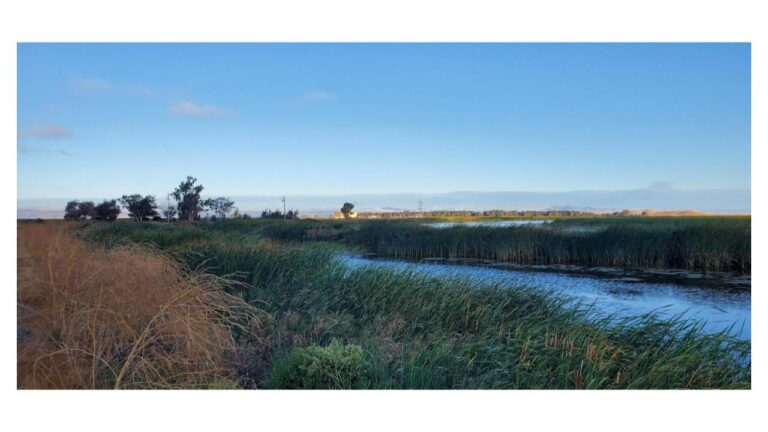Photo: Mary K. Miller
The drive down Fire Truck Road to the Montezuma Wetlands Project, where the Delta and Suisun Bay converge with the Sacramento and the San Joaquin rivers, feels out of place from much of the Bay Area, sparsely dotted as it is with farms, cattle and wind turbines rather than housing tracts. Stopping for a closer look, I see that part of this desolate grassland 20 miles from the city of Fairfield is undergoing a radical transformation. Adjacent to Fire Truck Road is low marsh with intertidal channels and ponds surrounded by tall swaths of tule, cattails and bulrush, while towards the foothills grow clumps of salt grass and pickleweed in high marsh.
What took tens of thousands of years for nature to build–the foundation of an ecosystem that is almost equal parts water and muddy ground–took two decades to recreate using a bit of ingenuity, a good business plan and a lot of sediment. The essential ingredient is mud transplanted from places in the Bay where it mucks things up and impedes ship traffic to places where it can be put to good use.
Twenty years after the first barge-full of sediment dredged from the Oakland harbor arrived, the Montezuma site has deployed eight million cubic yards (CY) of the material to raise the subsided pastures and diked baylands back to tidal levels and create 550-acres of healthy wetlands. In the process, endangered mice and young salmon that once thrived here have returned in measurable numbers. Today, the ambitious project continues to demonstrate how the beneficial reuse of dredged sediment can help the region’s wetlands keep pace with rising sea levels.
“We’re probably going to take a million and a half cubic yards this year alone, which is our biggest year ever,” said Jim Levine, director of the privately owned Montezuma Project.
Montezuma Wetlands’ ambitious design, sustainable funding and industrial-level infrastructure are badly needed if the Bay Area is to meet the challenges of coastal resilience and climate change. Like coastal and bay communities across the country, wetlands restoration in the San Francisco Bay and Delta is on a collision course with sea level rise and flooding from extreme storms. According to the San Francisco Bay Conservation and Development Commission (BCDC) and other agencies, the Bay Area needs to restore 25,000 acres of tidal marsh by 2050 to buffer and protect communities and valuable infrastructure (estimates from a recent inventory put the value of at-risk parcels and roadways at $236 billion). That means fast-tracking new and existing restoration projects like the Montezuma Wetlands, which I visited recently on a warm fall day with its director Jim Levine.
NO MUCKING ABOUT
Owned and operated as a private LLC, the heart of Montezuma Wetlands project looks like an industrial harbor with a hulking electric Liberty offloader snorkeling a slurry of sediment and water from a dredge barge docked alongside. At pressures of 200-300 psi, the mud is pumped from the barge through a complex of pipes and valves to deliver it inland and build up land that had subsided 10 feet below sea level after being diked and drained in the late 1800s. Nearby, earth movers shape berms to form enclosed cells with space between them for water to flow, like veins in a leaf. Each cell is individually […]
Full article: mavensnotebook.com

